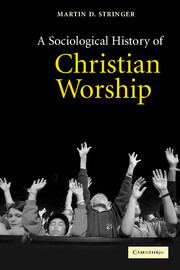Book contents
- Frontmatter
- Contents
- Preface and acknowledgements
- Introduction: Discourse, devotion and embodiment
- 1 Early Christian worship, texts and contexts to ad 300
- 2 Worship and the Christianisation of public space, 300–600
- 3 Hegemonic discourses in the worship of empires, 600–900
- 4 The dominant discourse of cosmological Christianity, 900–1200
- 5 Accessing the demotic discourses of devotion, 1200–1500
- 6 Worship and the rise of humanistic discourses, 1500–1800
- 7 The globalisation of Christian worship, 1800–2000
- Bibliography
- Index
1 - Early Christian worship, texts and contexts to ad 300
Published online by Cambridge University Press: 03 December 2009
- Frontmatter
- Contents
- Preface and acknowledgements
- Introduction: Discourse, devotion and embodiment
- 1 Early Christian worship, texts and contexts to ad 300
- 2 Worship and the Christianisation of public space, 300–600
- 3 Hegemonic discourses in the worship of empires, 600–900
- 4 The dominant discourse of cosmological Christianity, 900–1200
- 5 Accessing the demotic discourses of devotion, 1200–1500
- 6 Worship and the rise of humanistic discourses, 1500–1800
- 7 The globalisation of Christian worship, 1800–2000
- Bibliography
- Index
Summary
INTRODUCTION: CONTEXTUALISATION
In my Introduction I explored the way in which we have to understand worship as a form of discourse. I argued that a purely textual or theological approach to worship was not adequate. I said that in this book I would be exploring the practice of worship, trying to understand the way in which ordinary people approached their worship. This still remains my focus. However, when we go back to the very beginnings of Christian worship, it is only texts that we have to work with. What is more, these texts are partial and limited. They emerge from many different places and over considerable periods of time. It is difficult to see any coherent narrative within or between them. While in the Foucaultian sense all these texts act as ‘statements’ within an emerging Christian discourse, it is not easy to see that discourse in anything other than an entirely fragmentary form. We have to recognise this, therefore, as we begin to sift through and explore the evidence that we have.
One of the biggest obstacles facing scholars in understanding the nature of Christianity in the first few centuries after the death of Jesus is the temptation to read back presuppositions drawn from the subsequent two thousand years of Christian history. This has been particularly true in the area of worship.
- Type
- Chapter
- Information
- A Sociological History of Christian Worship , pp. 26 - 57Publisher: Cambridge University PressPrint publication year: 2005

